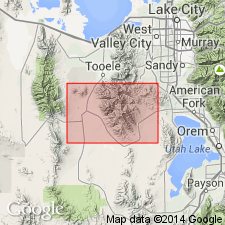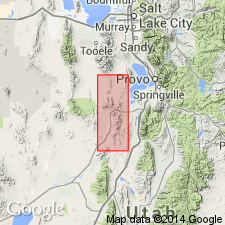
- Usage in publication:
-
- Great Blue limestone*
- Modifications:
-
- Revised
- AAPG geologic province:
-
- Great Basin province
Summary:
A name applied by miners; name retained because of its widespread use, even though no type locality designated and name Great Blue has no geographic significance. Rests conformably on the Upper Mississippian Humbug formation; lower Great Blue contact placed at the top of the highest "considerable" group of sandstone beds. Gradationally overlain by the Mississippian and Pennsylvanian Manning Canyon shale (new); the transition takes place over 200 to 300 ft in which the quantity of shale increases over the quantity of limestone. Consists of blue-gray limestone divisible into three parts by a shale. Separated into a 1) lower limestone about 500 ft thick, 2) Long Trail shale member (new), 85-ft-thick black carbonaceous shale, and 3) upper limestone member 2,400 to 3,100 ft thick. No marker units, other than Long Trail, were found in Great Blue. The upper contact revised in that the upper shale and limestone of the original Great Blue limestone--750 to 1,140 ft thick--is removed from Great Blue and reassigned to the newly named Manning Canyon shale. Fossils (pelecypods, crinoids, brachiopods) listed. Late Mississippian age.
Source: GNU records (USGS DDS-6; Denver GNULEX).

- Usage in publication:
-
- Great Blue formation*
- Modifications:
-
- Revised
- Overview
- AAPG geologic province:
-
- Great Basin province
Summary:
Divided in Great Basin province into four newly named members (ascending order): Topliff limestone member; Paymaster member; Chiulos member; and Poker Knoll limestone member. Full thickness known only on northeast slopes of Topliff Hill. The four members aggregate about 2,500 ft thick. Overlies Humbug formation conformably. Underlies Manning Canyon shale. Measured sections of type sections of Topliff, Paymaster, and Chiulos described. The Poker Knoll is not well exposed. Of Late Mississippian age. Geologic map. Cross sections.
Source: GNU records (USGS DDS-6; Denver GNULEX).
For more information, please contact Nancy Stamm, Geologic Names Committee Secretary.
Asterisk (*) indicates published by U.S. Geological Survey authors.
"No current usage" (†) implies that a name has been abandoned or has fallen into disuse. Former usage and, if known, replacement name given in parentheses ( ).
Slash (/) indicates name conflicts with nomenclatural guidelines (CSN, 1933; ACSN, 1961, 1970; NACSN, 1983, 2005, 2021). May be explained within brackets ([ ]).

